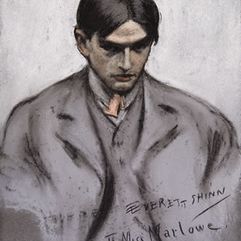

Everett Shinn
1876 - 1953
Everett Shinn was an American painter and member of the urban realist Ashcan School.
Shinn started as a newspaper illustrator in Philadelphia, demonstrating a rare facility for depicting animated movement, a skill that would, however, soon be eclipsed by photography. Here he worked with William J. Glackens, George Luks and John Sloan, who became core-members of the Ashcan School, led by Robert Henri, which defied official good taste in favour of robust images of real life. Shinn is best known for scenes of disaster or street violence, as well as theatrical subjects, regarding the theatre as a place of satisfying illusion. Shinn was the only Ashcan artist who preferred to work in pastels. He was reportedly a model for the protagonist of Theodore Dreiser's novel The "Genius".
Career
Most art historians, as well as Shinn himself, consider his employment by the Philadelphia Press the true beginning of his art career. He was entering the field of newspaper illustration in its heyday, and he was a draughtsman of great facility. (In later years, Shinn would express his dismay over the development of photography as the new art form that eventually replaced drawing as the principal source of visuals in all American newspapers.) Shinn moved from paper to paper for the rest of his illustrating career, receiving a larger salary with each move. The ability to convey animated movement and the attention to detail necessary for his newspaper illustrations is reflected in Shinn's paintings and pastels, especially those treating urban themes. In 1899, he quit the newspaper business and began working for Ainslee's Magazine, a magazine that also employed his wife, who was by that time a successful illustrator and who brought in a good deal of the household income. He ultimately illustrated for a wide range of popular journals over the next twenty years, including Harper's, Vanity Fair, Life, Look, and Judge. Shinn also started displaying his paintings and pastels publicly in 1899 to mixed reactions. In 1900, he and Flossie traveled to Europe to allow him an opportunity to study other painters and to prepare to produce enough work for another exhibition. The trip influenced his art in years to come; he was especially taken with Impressionism and European art that focused on depictions of the theater.
Shinn has said of his experience at the Philadelphia Press:
"In the Art Department of the Philadelphia Press on wobbling, ink-stained drawing boards William J. Glackens, George Luks, Everett Shinn and John Sloan went to school, a school now lamentably extinct…a school that trained memory and quick perception."
It was during Shinn's time in Philadelphia that artists Robert Henri, John Sloan, and Joseph Laub established the Charcoal Club as an informal alternative art school. The group, which included Henri, Sloan, Shinn, and fellow illustrators and would-be painters like William Glackens and George Luks, reached a peak membership of thirty-eight and sketched nudes and critiqued of each other's work. The club, which was both ribaldly social and intellectual, is often thought of a point of origin for what became known as the Ashcan school of American art. To his friends and fellow artists, Henri (the elder statesman of the group) urged the study of Whitman, Emerson, Zola, and Ibsen and the need for painters to forge a new style of art that spoke more to their time and experience. He believed that younger artists should look to the modern city for their subject matter and paint in a freer, less academic style than art lovers of the time were accustomed to. It was an outlook with which Shinn readily agreed.
Text courtesy of Wikipedia, 2024





















